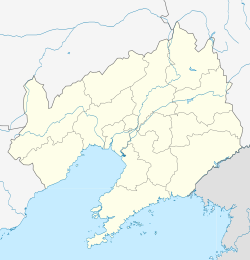Dandong
丹东市 Tantung, Antung | |
|---|---|
 View of Dandong's skyline on the Yalu River | |
 Location of Dandong City jurisdiction in Liaoning | |
| Coordinates (Dandong Customs): 40°07′16″N 124°23′39″E / 40.1211°N 124.3943°E | |
| Country | People's Republic of China |
| Province | Liaoning |
| Municipal seat | Zhenxing District |
| Districts and Counties | List
|
| Government | |
| • CCP Secretary | Pei Weidong |
| • Congress Chairperson | Yu Bing |
| • Mayor | Hao Jianjun |
| • Prefectural CPPCC Chairperson | Song Liyue |
| Area | |
| 14,782 km2 (5,707 sq mi) | |
| • Urban | 995.2 km2 (384.2 sq mi) |
| • Metro | 1,184.2 km2 (457.2 sq mi) |
| Elevation | 8 m (27 ft) |
| Population (2020 census)[1] | |
| 2,188,436 | |
| • Density | 150/km2 (380/sq mi) |
| • Urban | 815,858 |
| • Urban density | 820/km2 (2,100/sq mi) |
| • Metro | 1,175,199 |
| • Metro density | 990/km2 (2,600/sq mi) |
| GDP[2] | |
| • Prefecture-level city | CN¥ 89 billion US$ 15.8 billion |
| • Per capita | CN¥ 40,791 US$ 6,549 |
| Time zone | UTC+8 (China Standard) |
| Postal code | 118000 |
| Area code | 415 |
| ISO 3166 code | CN-LN-06 |
| Licence plates | 辽F |
| Administrative division code | 210600 |
| Website | www |
| Dandong | |||||||||
|---|---|---|---|---|---|---|---|---|---|
 "Dandong", as written in Chinese | |||||||||
| Simplified Chinese | 丹东 | ||||||||
| Traditional Chinese | 丹東 | ||||||||
| Postal | Tantung Antung (until 1965) | ||||||||
| |||||||||
| Andong | |||||||||
| Simplified Chinese | 安东 | ||||||||
| Traditional Chinese | 安東 | ||||||||
| Postal | Antung | ||||||||
| |||||||||
Dandong (simplified Chinese: 丹东; traditional Chinese: 丹東; pinyin: Dāndōng; lit. "Red East"), formerly known as Andong, is a coastal prefecture-level city in southeastern Liaoning province, in the northeastern region of the People's Republic of China.
It is the largest Chinese border city,[3] facing Sinuiju, North Korea, across the Yalu River, which demarcates the Sino-North Korean border. To the southwest of the city, the river flows into Korea Bay. Dandong has therefore had a dynamic history because of its strategic location for the northeast's rich natural resources and because of its convenient access to the ocean. It is designated as a major export production centre for the province, and is a port city connected by rail with Shenyang and Sinuiju. A significant amount of trade with North Korea flows through the city.[4]
The size of the administrative city (prefecture) is 14,981.4 square kilometres (5,784.4 sq mi).[5] As of the 2020 census, its population was 2,188,436 inhabitants and the built-up area made of 3 urban districts is 830 square kilometres (320 sq mi) (815,576 inhabitants) and Sinuju, the North Korean neighboring city (359,341 inhabitants), was home to 1,175,199 inhabitants in 2020.[1]
- ^ a b "China: Liáoníng (Prefectures, Cities, Districts and Counties) - Population Statistics, Charts and Map". www.citypopulation.de.
- ^ 辽宁省统计局、国家统计局辽宁调查总队 (October 2016). 《辽宁统计年鉴-2016》. 中国统计出版社. ISBN 978-7-5037-7900-8. Archived from the original on 2017-06-05. Retrieved 2017-06-05.
- ^ Rogers, Jenny. "New group reaches out to China Archived 2012-10-06 at the Wayback Machine." Gold Coast Bulletin. October 2, 2012. Retrieved on October 23, 2012.
- ^ Kanto, Dick K. and Mark E. Manyin. China-North Korea Relations. DIANE Publishing. December 28, 2010. 10. Retrieved from Google Books on October 23, 2012. ISBN 1437985114, 9781437985115.
- ^ 中国丹东-丹东概貌导航-自然地理 (in Chinese (China)). Dandong Municipal Government. 15 June 2005. Archived from the original on 2011-07-24. Retrieved 2011-04-17.
